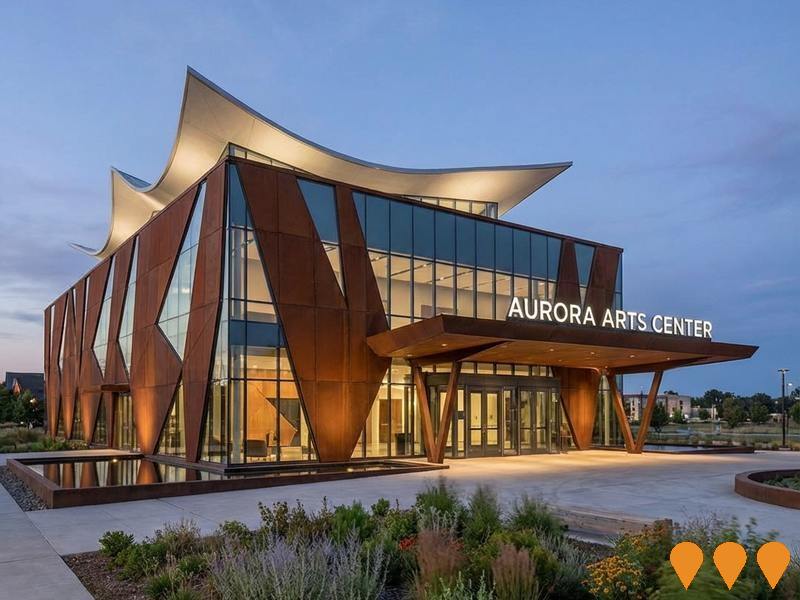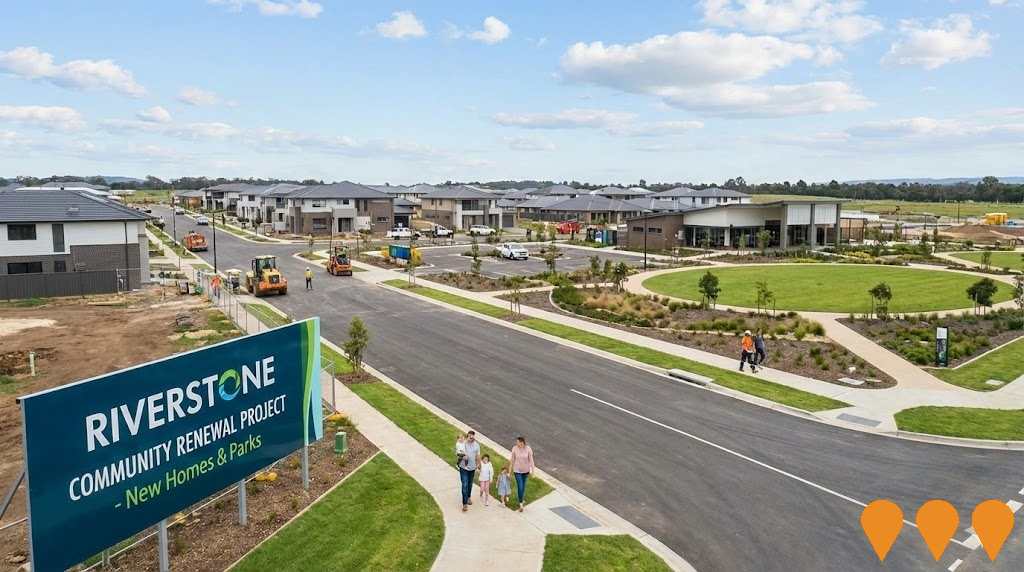Chart Color Schemes
est. as @ -- *
ABS ERP | -- people | --
2021 Census | -- people
Sales Activity
Curious about local property values? Filter the chart to assess the volume and appreciation (including resales) trends and regional comparisons, or scroll to the map below view this information at an individual property level.
Find a Recent Sale
Sales Detail
Population
Highett (East) - Cheltenham lies within the top quartile of areas nationally for population growth performance according to AreaSearch analysis of recent, and medium to long-term trends
Highett (East) - Cheltenham's population is approximately 26,036 as of August 2025. This figure represents an increase of 1,951 people since the 2021 Census, which recorded a population of 24,085. The estimated resident population in June 2024 was 25,866, with an additional 645 validated new addresses since the Census date contributing to this growth. This results in a population density of 2,978 persons per square kilometer, placing Highett (East) - Cheltenham in the upper quartile nationally according to AreaSearch's assessments. The area's population grew by 8.1% between the 2021 Census and August 2025, outpacing both the SA3 area (5.6%) and the SA4 region. Overseas migration accounted for approximately 84.4% of overall population gains during recent periods, with all drivers contributing positively to growth.
AreaSearch uses ABS/Geoscience Australia projections released in 2024 with a base year of 2022 for each SA2 area. For areas not covered by this data, AreaSearch employs the VIC State Government's Regional/LGA projections released in 2023, adjusting using a method of weighted aggregation from LGA to SA2 levels. Growth rates by age group are applied across all areas for years 2032 to 2041. Based on these trends, Highett (East) - Cheltenham is projected to experience above median population growth, with an expected increase of 5,390 persons by 2041, resulting in a total increase of 20.1% over the 17-year period.
Frequently Asked Questions - Population
Development
AreaSearch assessment of residential development activity positions Highett (East) - Cheltenham among the top 25% of areas assessed nationwide
Highett East - Cheltenham has recorded approximately 202 residential properties granted approval per year over the past five financial years, totalling 1,011 homes from FY-21 to FY-25. As of FY-26, six approvals have been recorded. On average, 1.3 people move to the area annually for each dwelling built during this period, suggesting balanced supply and demand with stable market conditions. The average construction cost value of new homes is $603,000, slightly above the regional average, indicating a focus on quality developments.
In FY-26, commercial approvals totalling $47.8 million have been registered, reflecting high local commercial activity. Compared to Greater Melbourne, Highett East - Cheltenham records 51.0% more new home approvals per capita, offering buyers greater choice. New building activity consists of 19.0% standalone homes and 81.0% townhouses or apartments, promoting higher-density living and creating affordable entry points for downsizers, investors, and first-home buyers. This shift contrasts with the current housing mix of 54.0% houses, reflecting reduced development site availability and evolving lifestyle demands and affordability requirements. The area has approximately 245 people per dwelling approval, indicating room for growth. Projections suggest Highett East - Cheltenham will grow by 5,220 residents by 2041.
At current development rates, new housing supply should comfortably meet demand, providing good conditions for buyers and potentially supporting population growth beyond current projections.
Frequently Asked Questions - Development
Infrastructure
Highett (East) - Cheltenham has strong levels of nearby infrastructure activity, ranking in the top 30% nationally
Changes to local infrastructure significantly influence an area's performance. AreaSearch identified 20 projects that could impact the area. Notable projects include Sanctuary Sandringham, Suburban Rail Loop East - Cheltenham Station, Cheltenham Precinct Structure Plan - Suburban Rail Loop East, and Cycle Sandringham Infrastructure. The following list details those most relevant.
Professional plan users can use the search below to filter and access additional projects.
INFRASTRUCTURE SEARCH
 Denotes AI-based impression for illustrative purposes only, not to be taken as definitive under any circumstances. Please follow links and conduct other investigations from the project's source for actual imagery. Developers and project owners wishing us to use original imagery please Contact Us and we will do so.
Denotes AI-based impression for illustrative purposes only, not to be taken as definitive under any circumstances. Please follow links and conduct other investigations from the project's source for actual imagery. Developers and project owners wishing us to use original imagery please Contact Us and we will do so.
Frequently Asked Questions - Infrastructure
Suburban Rail Loop East - Cheltenham Station
Major underground metro station as part of the Suburban Rail Loop East project (26km fully automated orbital metro line). The station will be the southern gateway to the SRL network, located about 17m below ground under part of Sir William Fry Reserve. It will be an interchange point for the existing Frankston line and will include a new bus interchange, improved walking/cycling connections, and potential retail tenancies. Construction is underway, with tunnel boring machines to launch in 2026. The station is scheduled to open in 2035 and is expected to serve 70,000 daily trips on SRL East, with around 8,000 passengers using the Cheltenham station daily. The new pedestrian and cyclist bridge over Bay Road will connect the SRL station to Southland Shopping Centre and Southland Station.

Cheltenham Precinct Structure Plan - Suburban Rail Loop East
The Cheltenham Precinct Structure Plan guides transit-oriented development around the new underground Cheltenham station on Suburban Rail Loop East. The plan supports approximately 4,500 new dwellings, 11,400 additional residents and 12,000 new jobs by 2041, with mixed-use development, improved public spaces, active transport links and building heights up to 18 storeys.

Bluff Road Hampton East Redevelopment
Major social and affordable housing redevelopment replacing 146 older public housing units with 285 modern, energy-efficient dwellings (170 social housing, 32 affordable rental, 83 market rental) plus specialist disability accommodation. Delivered via the Victorian Government's Ground Lease Model with a 40-year lease. Features 5-star Green Star rating, average 7-star NatHERS, new community facilities including cafe, multi-purpose room, community garden, children's playground and landscaped open space.

Highett Common
A major urban renewal project on the former CSIRO site, featuring 1022 dwellings across 14 buildings, 4 hectares of conserved open space including a 3-hectare conservation area and 1-hectare public park. Victoria's first Net Zero Community featuring all-electric homes, solar panels, EV charging, and extensive resident amenities including pools, gyms, wellness hubs, and a public library.

Sanctuary Sandringham
Major mixed-use development at 248-250 Bay Road featuring 71 apartments and 4 townhouses. Contemporary design with marble finishes and European oak flooring.

Key Industrial Park - Stage 3
Premium industrial estate development delivering modern warehouses and office facilities in the heart of Moorabbin's industrial precinct.

Beaumaris Art Group Studios Renewal
Heritage-sensitive renovation and expansion of mid-century arts studio to support access and inclusion. Co-designed with Beaumaris Arts Group, heritage and accessibility advisors.

Banksia Apartments Cheltenham
Contemporary urban living development at 216-226 Charman Road, Cheltenham. Luxury apartments in heart of growing suburb near Beaumaris.

Employment
AreaSearch assessment indicates Highett (East) - Cheltenham faces employment challenges relative to the majority of Australian markets
Highett East - Cheltenham has an educated workforce with professional services well-represented. The unemployment rate was 6.7% as of June 2025.
There were 13,978 residents employed, with an unemployment rate of 6.7%, 2.0% higher than Greater Melbourne's rate of 4.6%. Workforce participation was similar to Greater Melbourne's at 64.1%. Key industries for employment among residents are health care & social assistance, professional & technical services, and retail trade. Finance & insurance has notable concentration with employment levels at 1.3 times the regional average, while transport, postal & warehousing shows lower representation at 3.4% compared to the regional average of 5.2%.
Many residents commute elsewhere for work based on Census working population data. Between June 2024 and June 2025, the labour force increased by 1.4%, while employment declined by 1.4%, causing unemployment to rise by 2.7 percentage points. Greater Melbourne recorded employment growth of 3.5% during this period. Jobs and Skills Australia's national employment forecasts from May 2025 project national employment growth of 6.6% over five years and 13.7% over ten years, with varying growth rates across industry sectors. Applying these projections to Highett East - Cheltenham's employment mix suggests local growth of approximately 6.8% over five years and 13.9% over ten years.
Frequently Asked Questions - Employment
Income
The area exhibits notably strong income performance, ranking higher than 70% of areas assessed nationally through AreaSearch analysis
According to AreaSearch's aggregation of latest postcode level ATO data released for financial year ended June 2022, Highett (East) - Cheltenham had a median income among taxpayers of $60,715 with the average level standing at $78,183. These figures are significantly higher than national averages of $54,892 and $73,761 across Greater Melbourne respectively. Based on Wage Price Index growth rate of 12.16% since financial year ended June 2022, current estimates would be approximately $68,098 (median) and $87,690 (average) as of September 2025. According to Australian Bureau of Statistics Census data from 2021, household, family and personal incomes in Highett (East) - Cheltenham cluster around the 63rd percentile nationally. Distribution data shows that 30.2% of the population, equating to 7,862 individuals, fall within the $1,500 - $2,999 income range, which is similar to regional levels where 32.8% occupy this range. High housing costs consume approximately 16.6% of income, however strong earnings still place disposable income at the 56th percentile nationally. The area's SEIFA income ranking places it in the 7th decile.
Frequently Asked Questions - Income
Housing
Highett (East) - Cheltenham displays a diverse mix of dwelling types, with a higher proportion of rental properties than the broader region
Highett (East) - Cheltenham's dwelling structure, as assessed in the latest Census, consisted of 54.2% houses and 45.8% other dwellings. Compared to Melbourne metro's 54.8% houses and 45.2% other dwellings, Highett (East) - Cheltenham had a slightly higher proportion of houses. Home ownership in the area was 33.9%, aligning with Melbourne metro's figure. The remaining dwellings were either mortgaged at 37.8% or rented at 28.3%. The median monthly mortgage repayment was $2,167, similar to Melbourne metro's average. The median weekly rent figure was $421, compared to Melbourne metro's $410. Nationally, Highett (East) - Cheltenham had higher mortgage repayments at $2,167 versus the Australian average of $1,863, and substantially higher rents at $421 compared to Australia's $375.
Frequently Asked Questions - Housing
Household Composition
Highett (East) - Cheltenham features high concentrations of lone person households, with a lower-than-average median household size
Family households account for 66.7 percent of all households, including 30.5 percent couples with children, 24.4 percent couples without children, and 10.6 percent single parent families. Non-family households constitute the remaining 33.3 percent, with lone person households at 30.7 percent and group households comprising 2.7 percent of the total. The median household size is 2.3 people, which is smaller than the Greater Melbourne average of 2.4.
Frequently Asked Questions - Households
Local Schools & Education
Highett (East) - Cheltenham shows strong educational performance, ranking in the upper quartile nationally when assessed across multiple qualification and achievement indicators
In Highett (East)-Cheltenham, educational qualifications surpass regional averages, with 37.9% of residents aged 15+ holding university degrees compared to the SA4 region's 46.0%. The most prevalent qualification is bachelor degrees at 25.2%, followed by postgraduate qualifications at 9.2% and graduate diplomas at 3.5%. Vocational credentials are also prominent, with 28.8% of residents aged 15+ holding such qualifications, including advanced diplomas (12.3%) and certificates (16.5%). Educational participation is high, with 27.0% of residents currently enrolled in formal education, comprising 8.7% in primary, 6.7% in secondary, and 5.3% in tertiary education.
The area's five schools have a combined enrollment of 1,937 students, serving distinct age groups with four primary and one secondary school. However, local school capacity is limited (7.4 places per 100 residents vs the regional average of 15.7), leading many families to seek schooling in nearby areas.
Frequently Asked Questions - Education
Schools Detail
Nearby Services & Amenities
Transport
Transport servicing is high compared to other areas nationally based on assessment of service frequency, route connectivity and accessibility
Highett (East) - Cheltenham has 116 active public transport stops. These are a mix of train and bus stations. They are serviced by 26 different routes that together provide 9,505 weekly passenger trips.
Residents have excellent transport accessibility, with an average distance of 193 meters to the nearest stop. On average, there are 1,357 trips per day across all routes, which equates to approximately 81 weekly trips per individual stop.
Frequently Asked Questions - Transport
Transport Stops Detail
Health
Highett (East) - Cheltenham's residents are healthier than average in comparison to broader Australia with a fairly standard level of common health conditions seen across both young and old age cohorts
Health data shows Highett (East) - Cheltenham residents have relatively positive health outcomes.
Common health conditions are seen at a fairly standard level across both young and old age cohorts. Private health cover is exceptionally high, at approximately 59% of the total population of 15,309 people. The most common medical conditions in the area are mental health issues and asthma, affecting 7.8% and 7.5% of residents respectively. 70.0% of residents declare themselves completely clear of medical ailments, compared to 70.4% across Greater Melbourne. 19.6% of residents are aged 65 and over, totalling 5,090 people, which is broadly in line with the general population's health profile.
Frequently Asked Questions - Health
Cultural Diversity
Highett (East) - Cheltenham was found to be more culturally diverse than the vast majority of local markets in Australia, upon assessment of a range of language and cultural background related metrics
Highett East-Cheltenham is more culturally diverse than most local areas, with 32.7% of its population born overseas and 26.8% speaking a language other than English at home. Christianity is the predominant religion in Highett East-Cheltenham, making up 46.1%. Notably, Judaism comprises 1.9%, higher than the Greater Melbourne average of 1.1%.
In terms of ancestry, the top three groups are English (23.2%), Australian (20.1%), and Other (10.7%). Some ethnic groups show significant differences: Russian is overrepresented at 1.3% compared to 1.0% regionally, Greek at 4.7% versus 3.3%, and Polish at 1.2% compared to 1.0%.
Frequently Asked Questions - Diversity
Age
Highett (East) - Cheltenham's population is slightly older than the national pattern
The median age in Highett (East) - Cheltenham is 40, which is higher than Greater Melbourne's figure of 37 and Australia's figure of 38 years. The 75-84 cohort is notably over-represented locally at 6.9%, while the 25-34 age group is under-represented at 12.3%. Between 2021 and present, the 15 to 24 age group has grown from 9.7% to 10.4% of the population. Conversely, the 25 to 34 cohort has declined from 13.8% to 12.3%. Demographic modeling suggests that by 2041, Highett (East) - Cheltenham's age profile will evolve significantly. The 75 to 84 age cohort is projected to grow significantly, expanding by 1,146 people (63%) from 1,806 to 2,953. Notably, the combined 65+ age groups are expected to account for 54% of total population growth. Meanwhile, the 35 to 44 and 0 to 4 cohorts are expected to experience population declines.


